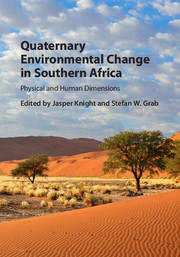Book contents
- Quaternary Environmental Change in Southern AfricaPhysical and Human Dimensions
- Quaternary Environmental Change in Southern Africa
- Copyright page
- Contents
- Contributors
- 1 The context of Quaternary environmental change in southern Africa
- 2 A brief geological history of southern Africa
- 3 A continental-scale perspective on landscape evolution in southern Africa during the Cenozoic
- 4 Hominin origins and evolution during the Neogene
- 5 Hominin evolution in Africa during the Quaternary
- 6 Quaternary environmental change on the southern African coastal plain
- 7 Dating the southern African landscape
- 8 Glacial and periglacial geomorphology
- 9 Colluvial deposits and slope instability
- 10 Desert dune environments
- 11 Changes in fluvial systems during the Quaternary
- 12 Wetlands in southern Africa
- 13 Sandy coasts
- 14 Environmental change during the Pleistocene and Holocene: Estuaries and lagoons of southern Africa
- 15 Soils and duricrusts
- 16 Karstic systems
- 17 Terrestrial ecosystem changes in the late Quaternary
- 18 Faunal evidence for mid- and late Quaternary environmental change in southern Africa
- 19 Pollen, charcoal and plant macrofossil evidence of Neogene and Quaternary environments in southern Africa
- 20 Minerogenic microfossil records of Quaternary environmental change in southern Africa
- 21 Development of the archaeological record in southern Africa during the Earlier Stone Age
- 22 Development of the archaeological record during the Middle Stone Age of South Africa
- 23 Later Stone Age hunter-gatherers and herders
- 24 Southernmost Africans, archaeology and the environment during the Holocene
- 25 Landscape–climate–human relations in the Quaternary of southern Africa
- Index
- References
16 - Karstic systems
Published online by Cambridge University Press: 05 June 2016
- Quaternary Environmental Change in Southern AfricaPhysical and Human Dimensions
- Quaternary Environmental Change in Southern Africa
- Copyright page
- Contents
- Contributors
- 1 The context of Quaternary environmental change in southern Africa
- 2 A brief geological history of southern Africa
- 3 A continental-scale perspective on landscape evolution in southern Africa during the Cenozoic
- 4 Hominin origins and evolution during the Neogene
- 5 Hominin evolution in Africa during the Quaternary
- 6 Quaternary environmental change on the southern African coastal plain
- 7 Dating the southern African landscape
- 8 Glacial and periglacial geomorphology
- 9 Colluvial deposits and slope instability
- 10 Desert dune environments
- 11 Changes in fluvial systems during the Quaternary
- 12 Wetlands in southern Africa
- 13 Sandy coasts
- 14 Environmental change during the Pleistocene and Holocene: Estuaries and lagoons of southern Africa
- 15 Soils and duricrusts
- 16 Karstic systems
- 17 Terrestrial ecosystem changes in the late Quaternary
- 18 Faunal evidence for mid- and late Quaternary environmental change in southern Africa
- 19 Pollen, charcoal and plant macrofossil evidence of Neogene and Quaternary environments in southern Africa
- 20 Minerogenic microfossil records of Quaternary environmental change in southern Africa
- 21 Development of the archaeological record in southern Africa during the Earlier Stone Age
- 22 Development of the archaeological record during the Middle Stone Age of South Africa
- 23 Later Stone Age hunter-gatherers and herders
- 24 Southernmost Africans, archaeology and the environment during the Holocene
- 25 Landscape–climate–human relations in the Quaternary of southern Africa
- Index
- References
Summary
This chapter describes the karstic systems in southern Africa and explores their role in preserving records of past environmental and climatic conditions and archaeology. On longer glacial–interglacial timescales, multiproxy studies of clastic and organic cave deposits and calcium carbonate precipitates (speleothems) have provided information about the environment in which early humans lived. Speleothems also have potential to show millennial to annual-scale climate/environmental variability. The advantages of speleothems to provide precise ages, and the empirical relationships between speleothem chemistry and climate, are encouraging as we address the need for more globally dispersed terrestrial palaeoclimatic records. Future research should focus not only on obtaining more records, but also on improving the precision of data interpretation in terms of quantitative estimations of climate variables.
- Type
- Chapter
- Information
- Quaternary Environmental Change in Southern AfricaPhysical and Human Dimensions, pp. 250 - 268Publisher: Cambridge University PressPrint publication year: 2016



